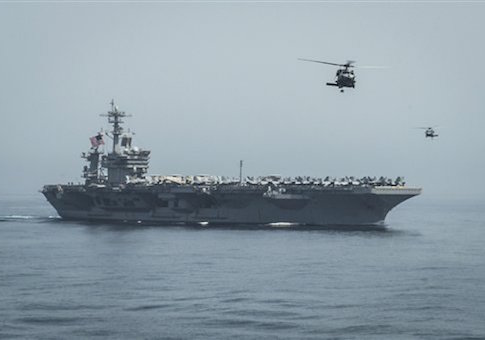Two former Pentagon officials believe that the U.S. Navy is currently "strained" because of its lack of ships.
The Hill reported that Seth Cropsey, who served as deputy undersecretary of the Navy for Presidents Ronald Reagan and George H.W. Bush, and retired Marine Col. Mark Cancian both recently made similar assessments of the Navy.
Their comments come just after a Navy official publicly acknowledged last week that there will be gaps in the presence of U.S. aircraft carriers in both the Middle East and East Asia regions at points next year.
Since the Navy removed the USS Theodore Roosevelt from the Persian Gulf last month, the U.S. has had no carrier in the sea, the first such instance since 2007. However, Cropsey described the entire Navy fleet, not just the aircraft carriers, as experiencing strain.
"The Navy is strained because the number of ships is down from where it was five, 10, 15 years ago, and the numbers of missions that it has, has increased from five, 10, 15 years ago," Cropsey said.
While the Navy’s goal is to have 303 ships by 2021, Cropsey put the "absolute minimum" number of needed ships much higher at 325.
"The absolute minimum is somewhere around 325 ships. … If we are serious about the threat that’s increasingly coming from states like China, Iran, Russia, and North Korea, specifically their efforts to deny access to the waters in their area, we need closer to a 350-ship Navy," Cropsey said.
Cancian, who from 2008 until April of this year headed the division of the Office of Management and Budget that develops the Department of Defense budget, agreed that the Navy is absolutely "strained."
"There’s no question that the Navy is strained," Cancian, who also worked in the Office of the Secretary of Defense, said. "Strained in the sense that the combatant commanders want more naval presence than the Navy can give them."
Navy Vice Adm. John Aquilino said at a congressional hearing last Tuesday that there will be "some periods" in 2016 when no U.S. aircraft carrier will be present in the Middle East and East Asia. According to Navy officials, the gaps in coverage are caused by a shortage in available carriers. The Navy needs 11 carriers to execute its missions, and it currently has only 10. The 11th aircraft carrier is not expected to be ready until 2021.
"Flying a couple of airplanes into an airbase just doesn’t give the visibility that sailing a ship into a harbor does," Cancian stated. "There’s nothing like sailing a carrier into someone’s harbor to make the point that the United States is here."
